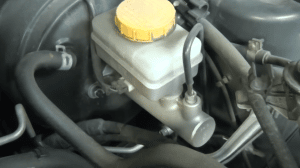As one of the most critical parts of an automobile, the brake light must function properly. When you push the brake pedal, a switch activates the lights. Brake lights let other drivers know whether you’re decreasing the speed or stop, so they can decelerate safely.
These lights, on the other hand, are supposed to be a safety function, but if they malfunction, they can oppositely endanger your life. Even though you can use OBD2 Scanner under 100 to identify the problem. It’s very important to learn the causes and how to fix them.
Why Brake Light On?
Brake lights indicate that there’s something wrong with your braking system. This includes when your brake fluid level is low, the emergency/hand brake has been engaged, the ABS unit is malfunctioning, or there is a sensor/switch issue.
Unlike Budget obd2 Scanner For Android and iOS devices, the problem is that the braking light itself doesn’t specifically tell you what’s actually wrong. Therefore you need to know the possible causes and the relevant solutions to fix them.
Possible Causes of Brake Light on
There are different factors that can cause the brake light on from the malfunctioning brake sensor to an incorrect brake light bulb. Each cause needs its own solution to get fixed so the light would turn off. You can use a scanner like Autel 519 to retrieve the code and you can check the possible causes below.
Malfunctioning Brake Sensor and/or Light Switch: If your brake lights aren’t working, it’s most likely because of this. Your brake warning lights will not turn off if the brake system’s internal switch is malfunctioning.
When the brake pedal is depressed, the brake lights are activated by the sensors and switches in the corresponding system. The lights are getting the erroneous message if one or both of them is malfunction. The switch itself is actually adjustable.
Faulty Brake Pedal’s Spring: As soon as you let go of the brake pedal, a spring returns it to its original position. There are times when this spring weakens as it gets older or worn.
The brake lights stay on because the pedal doesn’t return to its normal position after being released. Collateral wear on your brake pads and rotors can occur as a result of that condition as well.
Defective Braking Pedal: The faulty pedal is generally worse than a malfunctioning spring. The lights won’t turn off if you can’t lift your foot off the brake pedal.
It’s because the switch must be closed to turn off the light as the pedal has come back into the initial position. If the pedal falls to come back, it will continue to appear as if you are braking and the light won’t turn off.
Faulty Brake System’s Electric: The brake lights can be affected if there is an electrical problem in the corresponding system. The problems might occur in the components that make it more tricky to figure out. As a result, the lights may stay on, not illuminate or work intermittently due to these flaws.
Incorrect Brake Light Bulbs: There are two types of light bulbs: those with a single circuit and those with multiple circuitry. Installing a single-circuit light bulb in a socket designed to hold two separate circuits would short them and activate the brake lights. That’s why you need to ensure using the correct light bulb for replacements.
How To Fix Brake Light on
By now, you should be able to narrow down the various causes of your brake light being stuck on and perform the necessary diagnostics to fix it. With the help of a scanner like Innova 3150 on your hands, there are possible ways to fix the brake light but all troubleshoots should solve the root causes.
1. Inspecting The Switch
First of all, you need to unplug the battery before working on your car’s electrical system for a safe operation. At the very least, disconnect the negative terminal.
Release the battery ground cable nut with your hand or a socket wrench. Eye protection is essential when doing an examination of your brake pedal switch. Your goal in this step is to test the switch’s return to make sure it works.
2. Release the Parking Brake
Your problem may be as easy as an activated parking brake, despite the fact that this rarely occurs. Full retraction of the parking brake can free up your stuttering brake light.
3. Replace The Brake Light Switch
You can locate the switch that controls the brake lights near the pedal. If malfunctions, you must replace the circuit of the brake light in your vehicle’s electrical system.
Before detaching the switch component, disconnect and save the pigtail harness for later use. You must also remove the brake pedal switch. You’ll need the mounting hardware to install the new switch. Using electric tape, you can retain the pigtail in position in case the harness is released accidentally.
4. Inspect The Pedal Bumper
Worn brake pedal bumpers trigger the brake light switch so does a missing bumper. You can examine the floorboard and find any rubber crumbs to see whether or not the bumper has been worn. Replace missing and/or bumpers so it can close the braking circuit properly and the light would come off.
5. Replace The Bulb
Burnt-out or dead bulbs are a common brake light problem. Brake lights might wear out from long-term driving. This condition causes either stuck brake lights or non-working brake lights.
If you drive an older automobile, you’d likely need to change the bulb more frequently because they use standard bulbs instead of LEDs. If the circuit of the brake light is connected to the blinkers, you may also consider replacing the turn signal(s).
6. Save The Battery
If your brake light is broken or jammed, it will drain your battery. When this happens, disconnect your car’s battery when it’s off. This would preserve the power of the battery to start the car while the brake light is stuck. Before disconnecting the negative battery terminal, check the hood latch. If the brake warning light stays on after turning off the ignition, you can move to brake checking.
7. Clean Up The Brake Pedal
A stuck or non-closing brake pedal can also create a stuck or on brake light. It could be caused by the corrosive connector of the pedal and switch or the worn/malfunctioning rubber stopper. Clean up your pedal and the surrounding component to prevent malfunctioning.
8. Align/adjust The Switch and Pedal
Sometimes a stubborn brake light can be a non-electrical fault. Even when the brake switch and pedal are misaligned, this can cause a stuck brake light. Check the alignment of the brake switch and the pedal.
Pushing the stoplight switch should turn off the brake lights. You can adjust the switch to follow the pressed and released pedal position. If the alignment doesn’t solve the problem, then it could be the spring or electrical faults.
9. Inspect The Sockets
Faulty connections due to dirt or corrosion and old wiring might cause malfunctioning sockets and jammed brake lights. Clean out brake light sockets to prevent the connectors from sticking. You can either replace the wiring or socket to restore its performance. Brake sockets are an inexpensive investment and easy to install.
10. Check The Body Control Module(BCM)
Newer automobiles’ BCM connects to the brake light switch’s circuit and the brake lamps. The switch activates the brake lights by grounding the BCM. If the BCM is malfunctioning, the brake lights could stay on. Older automobiles don’t have a BCM because the switch powers the brake lights directly.
11. Ensure The Appropriate Brake Fluid Level

Low brake fluid affects braking and the sensor that would turn on the warning light. Maintain enough brake fluid levels to avoid illuminating brake lights.
Check the driver’s side master cylinder or brake fluid reservoir to ensure the correct level. You must check the level on a regular basis and change the oil when the time comes.
Conclusion
When the brake light comes on, there are some possible causes. A set of inspections and the use of a scanner like FOXWELL GT60 would help you figure out the actual cause so you can apply the relevant solutions to fix them.
If you know how to perform this yourself, you can save hundreds of dollars on expert service and avoid being reported or fined for not having working brake lights. As a result, you can ensure driving safety and keep peace of mind.
httpv://www.youtube.com/watch?v=W9fUOgB–ko

As a mechanical engineer, it’s easy for David to explain the functionality of the tool. David test most of the tools before writing a review. its help him to learn something new and suggest the best product for you.





